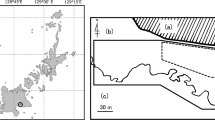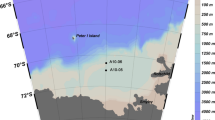Abstract
The biology of Octopus vulgaris Cuvier inhabiting subtropical littoral reefs off the east coast of South Africa was investigated. Analyses of stomach contents and lair middens revealed that the mussel Perna perna was the dominant food organism. Growth rate of captive individuals was higher than has previously been recorded but food conversion was lower. Females became sexually mature at 900 g which is estimated to be attained in 3.6 months. Males became sexually mature at 400 g, which is estimated to be attained after 3 months. Results indicate that females live for 9–12 months and have the potential to reach 4 000 g in 240 d while males live for about 12–15 months and have the potential to achieve 4 000 g in 290 d. Mating and breeding occurred throughout the year although evidence for the seasonal migration of females is presented and discussed in relation to breeding and feeding behaviour.
Similar content being viewed by others
Literature Cited
Altman, J. S.: The behaviour of Octopus vulgaris Lam. in its natural habitat: a pilot study. Underwater Association Report, pp 77–83 (1966–1967)
Berry, P. F.: The spiny lobsters (Palinuridae) of the east coast of southern Africa: distribution and ecological notes. Invest. Rep. oceanogr. Res. Inst. 27, 1–23 (1971)
Berry, P. F., P. Hanekom, C. S. W. Joubert, I. Joubert, M. Schleyer, M. J. Smale, and R. P. van der Elst: A preliminary account of the biomass and major energy pathways through a Natal nearshore reef community. Fourth National Oceanographic Symposium, Cape Town, 10–13 Jul 1979
Borer, K. T.: Control of food intake in Octopus briareus Robson. J. comp. physiol. Psychol. 75(2), 171–185 (1971)
Brown, M. E.: The growth of brown trout (Salmo trutta Linn.). III. The effect of temperature on the growth of two-year-old trout. J. exp. Biol. 22, 145–155 (1946)
Clarke, M. R.: The identification of cephalopod “beaks” and the relationship between beak size and total body weight. Bull. Br. Mus. nat. Hist. 8(10), 421–480 (1962)
Guerra, A.: Sobre la alimentacion y el comportamiento alimentario de Octopus vulgaris. Inv. Pesq. 42(2), 351–364 (1978)
Hatanaka, H.: Spawning seasons of common octopus off the Northwest coast of Africa. Bull. Jap. Soc. scient. Fish 45(7), 805–810 (1979)
Hyman, L. H.: The Invertebrates. Vol. 2: Platyhelminthes and Rhynchocoela. The acoelomate bilateria. 550 pp. New York: MrGraw-Hill 1951
Itami, K., Y. Izawa, S. Maeda, and K. Nakai: Notes on the laboratory culture of the octopus larvae. Bull. Jap. Soc. scient. Fish. 29(6), 514–520 (1963)
Joll, L. M.: Growth and food intake of Octopus tetricus (Mollusca: Cephalopoda) in aquaria. Aust. J. mar. freshwat. Res. 28,(1), 45–56 (1977)
Kayes, R. J.: The daily activity pattern of Octopus vulgaris in a natural habitat. Mar. Behav. Physiol. 2, 337–343 (1974)
Lee, H.: The octopus 114 pp. London: Chapman and Hall 1875
Mangold, K. and S. von Boletzky: New data on reproductive biology and growth of Octopus vulgaris. Mar. Biol. 19, 7–12 (1973)
Mangold-Wirz, K.: Biologie des Céphalopodes benthiques et nectoniques de la Mer Catalane. “Vie et Milieu” (13), 1–33 (1963)
Nigmatullin, C. M. and A. A. Ostapenko: Feeding of Octopus vulgaris Lam. from the Northwest African coast, 13 pp. Charlottenlund, Denmark: ICES 1976
Nixon, M.: Changes in body weight and intake of food by Octopus vulgaris. J. Zool. Lond. 150, 1–9 (1966)
Nixon, M.: The lifespan of Octopus vulgaris Lamarck. Proc. malac. Soc. Lond. (38), 529–540 (1969)
Rees, W. J.: The distribution of Octopus vulgaris Lam. in British waters. J. mar. biol. Ass. U.K. 29, 361–378 (1950)
Robson, G. C.: A monograph of the recent Cephalopoda. I: Octopodinae. London: Brit. Mus. (nat. Hist.) 1–236 (1929)
Roeleveld, M. A.: A revision of Massey's checklists of “South African” Cephalopoda. Ann. S. Afr. Mus. 66(2), 233–255 (1975)
Smale, M. J.: Migration, growth and feeding in the Natal rock lobster Panulirus homarus (Linnaeus). Invest. Rep. oceanogr. Res. Inst. (47), 1–56 (1978)
Vevers, H. G.: Observations on the laying and hatching of octopus eggs in the Society's aquarium. Proc. zool. Soc. Lond. 137, 311–315 (1961)
Wells, M. J.: Octopus. Physiology and behaviour of an advanced invertebrate. 417 pp. London: Chapman and Hall 1978
Wells, M. J. and J. Wells: Hormonal control of sexual maturity in Octopus. J. exp. Biol. 36(1), 1–33 (1959)
Wodinsky, J.: Breeding season of Octopus vulgaris. Mar. Biol. 16, 59–63 (1972)
Woods, J.: Octopus-watching off Capri. Animals 7 (12), 324–327 (1965)
Author information
Authors and Affiliations
Rights and permissions
About this article
Cite this article
Smale, M.J., Buchan, P.R. Biology of Octopus vulgaris off the east coast of South Africa. Marine Biology 65, 1–12 (1981). https://doi.org/10.1007/BF00397061
Accepted:
Issue Date:
DOI: https://doi.org/10.1007/BF00397061




